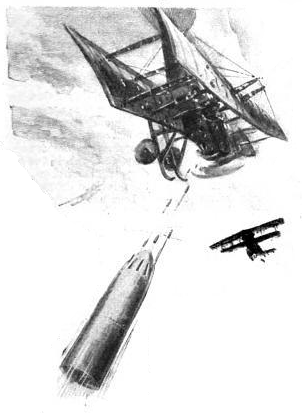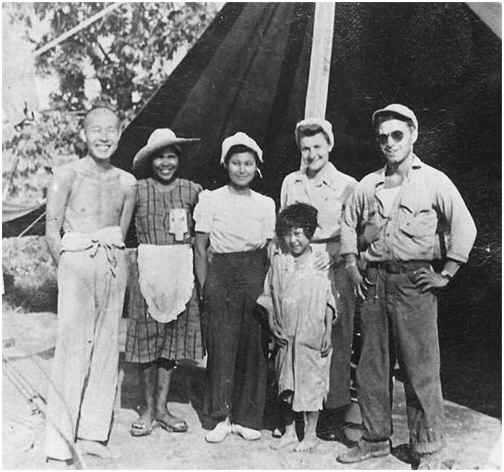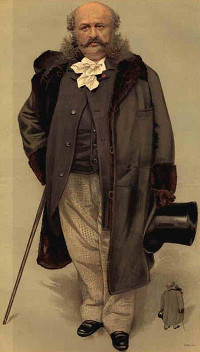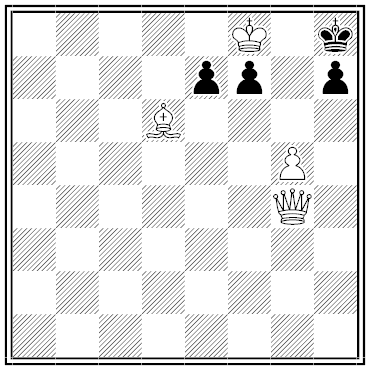- AWE and WONDER are synonyms, but AWFUL and WONDERFUL are antonyms.
- Abraham Lincoln is in the National Wrestling Hall of Fame.
- Ravel described Boléro as “a piece for orchestra without music.”
- “In politics, what begins in fear usually ends in folly.” — Coleridge
“The Gun Within a Gun”

This must set some sort of record for aggressiveness — during World War I, Andrew Graham invented a shell that fires bullets. From Popular Science Monthly, February 1918:
The projectile is pierced with a dozen or so of rifled channels, each constituting a barrel loaded with a regulation rifle cartridge. … A shell like that which Mr. Graham has conceived can be timed to discharge its bullets efficiently, far from its target, unlike shrapnel. The bullets do not lose in velocity, thanks to their elongated form and their rotation. Their velocity is the sum of the shell’s velocity and their own.
Actually aiming the bullets, though, is another matter. “The firing can be timed so that at least one volley will scatter properly.”
Mail Room
In the ‘London Times’ of 1841 a lady advertised in the columns of that newspaper for duplicates, which she put to a more curious use than most people. The advertisement said:– ‘A young lady being desirous of covering her dressing room with cancelled postage stamps, has been so far encouraged in her wish by private friends as to have succeeded in collecting 16,008. These, however, being insufficient, she will be greatly obliged if any good natured persons who may have these (otherwise useless) little articles at their disposal, would assist her whimsical project. Address, E.D., Mr Butt’s, Glover, Leadenhall Street, or Marshall’s, Jeweller, Hackney.’
— American Philatelist, Feb. 1, 1919
Tacet
William Bliss’ 1949 book The Real Shakespeare concludes with a “Shakespeare examination paper for reasonably advanced students.” It includes this question:
5. What character (and in what play) has the shortest part; appears only once (and that in a stage direction); and says nothing — and yet is essential to the plot?
I thought this might make a good puzzle — but I don’t know the answer! Bliss withholds his, and despite a lot of fumbling research I can’t find a significant player in Shakespeare who says nothing at all. Maybe the bear in The Winter’s Tale? I’ll leave it here as an open-ended riddle.
UPDATE: In the messages I’ve received, the most popular candidate is Banquo’s ghost in Macbeth. Banquo appears alive and speaks early in the play, but Macbeth has him murdered in Act III and his ghost haunts Macbeth silently thereafter, plaguing his conscience. In the stage directions, the ghost is called “Ghost of Banquo,” so arguably this is a distinct character.
09/13/2013 Another possibility: the corpse of Henry VI in Richard III. He appears once, carried in a coffin while Richard woos the mourning Lady Anne; he certainly says nothing; and his death and the victory of the Yorkists set off the events of the play. (Thanks, Josh.)
08/18/2015 An even better guess: Elizabeth I appears once, says nothing, and is onstage for less than 100 lines in Act V, Scene V of Henry VIII:
All the expected good we’re like to hear
For this play at this time, is only in
The merciful construction of good women;
For such a one we show’d ’em …
(Thanks, Joe.)
The Pied Piper of Saipan

Marine private Guy Gabaldon was 18 years old when he took part in the invasion of Saipan in the Mariana Islands in June 1944. In order to secure the island, Gabaldon began to go on “lone wolf” missions, using his smattering of Japanese to convince enemy civilians and troops to give themselves up.
“Immediately after landing on Saipan I decided that I would go off into enemy territory to fight the war as I saw fit,” he wrote in his 1990 memoir Saipan: Suicide Island. “I always worked alone, usually at night in the bush. I must have seen too many John Wayne movies, because what I was doing was suicidal.”
“My plan, as impossible as it seemed, was to get near a Japanese emplacement, bunker or cave, and tell them that I had a bunch of marines with me and we were ready to kill them if they did not surrender. I promised that they would be treated with dignity, and that we would make sure that they were taken back to Japan after the war.”
He must have been stupendously persuasive, because he captured 1,500 Japanese single-handed — including 800 on a single day in July. “When I began taking prisoners it became an addiction,” he wrote. “I found that I couldn’t stop — I was hooked.”
Gabaldon earned a Navy Cross for his efforts, and Jeffrey Hunter played him in the 1960 film Hell to Eternity. “The heroes are still over there,” he told the Chicago Tribune at the film’s opening. “Those who gave their all are the heroes.”
Black and White
In the Dark
From The Black-Out Book, a book of entertainments to amuse Londoners during the air-raid blackouts of 1939:
When a certain commodity was rationed, a woman wrote to her tradesman asking his advice.
He replied:
If the B mt, put :
If the B . putting :
What was the commodity, and what did he mean?
Top Secret

The Treaty of Berlin was drafted in secrecy, so its framers were astonished to find it published in the London Times. Journalist Henri de Blowitz at first refused to reveal his source, but at last relented near the end of his life. Well before the congress started he had attached a confederate to the clerical staff, but the man felt he was being watched, so the two could not dare to meet or talk. Finally de Blowitz noticed that they wore hats of the same type and color, and he hit on a plan of “childish simplicity.”
De Blowitz was staying at the Kaiserhof. Each day his confederate went there for lunch and dinner. The two never acknowledged one another, but they hung their hats on neighboring pegs. At the end of the meal the confederate departed with de Blowitz’s hat, and de Blowitz innocently took the confederate’s. The communications were hidden in the hat’s lining.
“Only twice were we forced to put off the communication till the following day,” de Blowitz wrote in his 1904 memoir. “Once, however, we had a scare.”
“One of my English colleagues, on leaving the dining-room, made a mistake and took my friend’s hat. Without looking at each other we felt, as he wrote me next day, that we turned pale. If the colleague in question had kept the hat, he might have discovered the third article of the treaty, which had been adopted at the previous day’s sitting, and also a hint of the difficulties that had arisen between Russia and England on the question of the boundaries of Bulgaria, and very disagreeable consequences for my friend might have been the result. Fortunately, on reaching the door, the Englishman put on the hat, which dropped over on his nose. He laughingly took it off and replaced it on its peg. I had risen to take the hat from him, but sat down again. I breathed freely, and my friend must have done the same.”
In a Word
oche
n. the line behind which darts players must stand
aimcrier
n. a person who cries “Aim!” to an archer; an applauder or encourager
Sudden Stop
Anthropologist George Bird Grinnell’s The Fighting Cheyennes (1915) describes “perhaps the only attempt to disable a railroad ever made by Indians.” A Cheyenne named Porcupine relates that in late summer 1867, after an embittering loss to U.S. soldiers in frontier Nebraska, his band witnessed “the first train of cars that any of us had seen. We looked at it from a high ridge. Far off it was very small, but it kept coming and growing larger all the time, puffing out smoke and steam, and as it came on we said to each other that it looked like a white man’s pipe when he was smoking.”
“Not long after this, as we talked of our troubles, we said among ourselves: ‘Now the white people have taken all we had and have made us poor and we ought to do something. In these big wagons that go on this metal road, there must be things that are valuable — perhaps clothing. If we could throw these wagons off the iron they run on and break them open, we should find out what was in them and could take whatever might be useful to us.”
They lay a stick across the tracks, which was enough to upset a handcar that appeared that night, and the Cheyenne killed the two men who had been working it. Encouraged, they used levers to pull out the spikes at the end of a rail and bent it a foot or two in the air. Presently they spotted two trains approaching and sent a party to assail the first one.
“When they fired, the train made a loud noise — puffing — and threw up sparks into the air, going faster and faster, until it reached the break, and the locomotive jumped into the air and the cars all came together. After the train was wrecked, a man with a lantern was seen coming running along the track, swearing in a loud tone of voice. He was the only one on the train left alive. They killed him. The other train stopped somewhere far off and whistled. Four or five men came walking along the track toward the wrecked train. The Cheyennes did not attack them. The second train then backed away.”
The Cheyenne would shortly be driven out of that country, but they relished this victory. “Next morning they plundered and burned the wrecked train and scattered the contents of the cars all over the prairie,” Porcupine relates. “They tied bolts of calico to their horses’ tails, and galloped about and had much amusement.”

